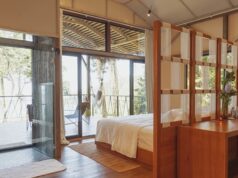 NATIONAL REPORT—Wyndham Worldwide’s headquarters has one. So does the Rivers Casino in Des Plaines, Ill., the Atlanta Airport Marriott Gateway, the Hampton Inn Elmira/ Horseheads (Horseheads, N.Y.) and numerous other hotel properties. What they all have is a white roof—a solar-reflective white coating to help reduce temperatures inside and out during those times when the building is most vulnerable to the sun’s impact.
NATIONAL REPORT—Wyndham Worldwide’s headquarters has one. So does the Rivers Casino in Des Plaines, Ill., the Atlanta Airport Marriott Gateway, the Hampton Inn Elmira/ Horseheads (Horseheads, N.Y.) and numerous other hotel properties. What they all have is a white roof—a solar-reflective white coating to help reduce temperatures inside and out during those times when the building is most vulnerable to the sun’s impact.
Having a white coating on a rooftop instead of a black coating can have a significant positive environmental and cost impact, especially in warmer climates. A roof covered with solar-reflective white paint reflects up to 90 percent of sunlight as opposed to the 20 percent reflected by a traditional black roof. On a 90°F day, a black roof can be up to 180°F while a white roof stays a cool 100°F. Cooling costs can be reduced up to 40 percent.
Used on a large scale, white roofs can help to reduce the urban heat island effect in large cities, reduce smog and improve breathing conditions. Electricity demand can be reduced, resulting in less air pollution and greenhouse gas emissions. White roofs can also lower the temperature of rainwater runoff that enters water systems.
Solar Reflectance, Thermal Emittance
The “coolness” of white roofs, like other cool roofs, is measured by two properties—solar reflectance and thermal emittance. Solar reflectance is the fraction of solar energy that is reflected by the roof. Thermal emittance is the relative ability of the roof surface to radiate absorbed heat. Both properties are measured from 0 to 1 and the higher the value, the cooler the roof.
Maciek Rupar, director of Technical Services, National Roofing Contractors Assn., says the best case scenario for a white roof is a building with a large roof area in a warm climate that is air-conditioned. Buildings in northern climates may not benefit from a white roof. In fact, he says, “A white roof will have the reverse effect in the winter time.”
Rupar says everything from climate to how a building is heated or cooled to what type of roof is already in place come into play when considering a white roof.
“The coating has to be compatible with the coating that is already there,” he says. “If you have an existing roof under warranty, make sure your coating will not jeopardize the warranty.”
Rupar adds that one should also consider the effect the white coating will have on moisture transfer in the roof. If the white coating stops that moisture pass-through, moisture may accumulate in the roof assembly, wood could begin to rot, and insulation may get wet.
Drainage, Cleanliness is Critical
Once it is determined that a white roof is a good solution, Rupar says one should try to coat as much of the existing roof as possible. Optimally, the roof should drain well. If dirt collects on the white roof, its effectiveness will be compromised. Periodic washing may be necessary.
Frank Campagna, senior v.p., real estate and facilities for Wyndham Worldwide, says the headquarters building that Wyndham leases has a rolled white thermal plastic polyolefin roof with welded seams. It not only adds the benefits described above but also increases the rooftop insulation by a factor of two and contributed a point toward the building’s LEED certification.
Campagna says the company that leases the building to Wyndham has made a white roof a standard for its new buildings. A building under construction adjacent to Wyndham’s headquarters, which Wyndham eventually will use, will get a PVC membrane type of roof cover that has an Energy Star rating.
Improved Performance
From a maintenance standpoint, Campagna says the polyolefin roof gets yearly inspections. He and his team make sure gutters are clean and only certain rooftop areas can be walked upon. When compared to traditional black roof coverings, Campagna says there is a lot less cracking.
The Cool Roof Rating Council provides a list of roof product types and links to organizations that provide contractor directories. The EPA also provides helpful information on cool roofs including a list of roofing materials with the Energy Star label that have met minimum solar reflectance and reliability criteria and how one can qualify for federal tax credits.
To learn more about the science of white roofs, click here.
Glenn Hasek can be reached at editor@greenlodgingnews.com.






